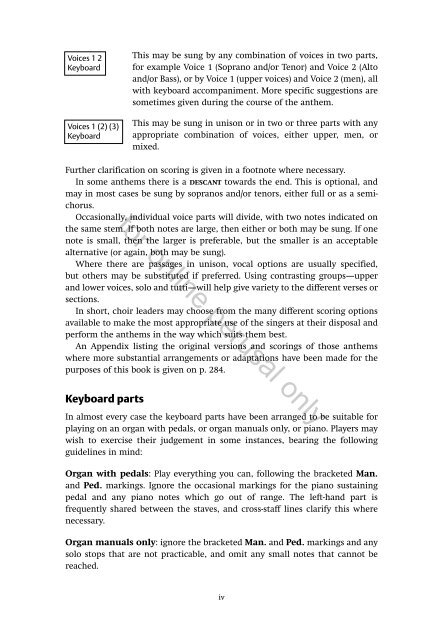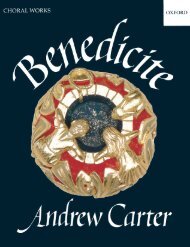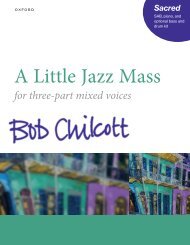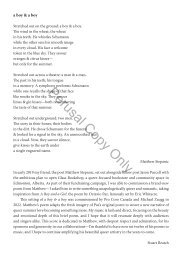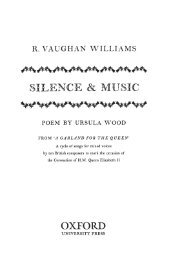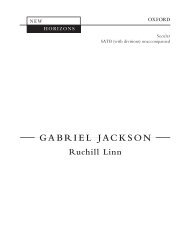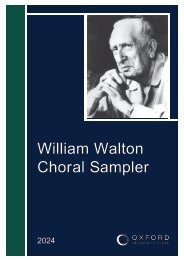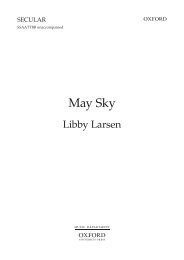- Page 1 and 2: Edited by Alan Bullard 4 The Oxford
- Page 3: 3 Great Clarendon Street, Oxford OX
- Page 7 and 8: Index of Titles and First Lines Whe
- Page 9 and 10: Listing by Liturgical Year and Them
- Page 11 and 12: Annunciation/BVM Gabriel to Mary ca
- Page 13 and 14: Voices 1 2 (3) (Keyboard)* 1. Allel
- Page 15 and 16: 25 V ‰ ‰ ‰. Š ‰ ‰ ˆ f 4
- Page 17 and 18: 6 SA(T)(B) Keyboard 2. Author of li
- Page 19 and 20: S. A./ T./B. 8 Author of life divin
- Page 21 and 22: 10 S(A)(Men) Keyboard 3. Be still,
- Page 23 and 24: 12 Be still, for the presence of th
- Page 25 and 26: 14 S(A)(T)(B) Keyboard 4. Bread of
- Page 27 and 28: 16 Bread of the world O V # 38 ‰
- Page 29 and 30: 18 Bread of the world S. A. T. B. V
- Page 31 and 32: S./A. 20 Brightest and best of the
- Page 33 and 34: 22 Brightest and best of the sons o
- Page 35 and 36: 24 Brightest and best of the sons o
- Page 37 and 38: 26 Christians, shout for joy and gl
- Page 39 and 40: 28 Christians, shout for joy and gl
- Page 41 and 42: 30 Christians, shout for joy and gl
- Page 43 and 44: 32 Christ is the world’s true Lig
- Page 45 and 46: 34 Christ is the world’s true Lig
- Page 47 and 48: 36 S(A)(Men) Keyboard 8. Christ the
- Page 49 and 50: S. A. MEN 38 Christ the Lord is ris
- Page 51 and 52: 40 Christ the Lord is ris’n again
- Page 53 and 54: S./A. MEN 15 Vbbb ‰. [ ‰ Š Š
- Page 55 and 56:
55 p Vbbb ‰ Š Š ‰. =( ) ‰
- Page 57 and 58:
46 SA(T)(B)* Keyboard for Tim and N
- Page 59 and 60:
S./T. A./B. 48 Come down, O Love di
- Page 61 and 62:
50 Come down, O Love divine 53 Vbbb
- Page 63 and 64:
52 S(A)(Men) Keyboard to Jeremy S.
- Page 65 and 66:
54 Creator of the stars of night 31
- Page 67 and 68:
56 Creator of the stars of night V
- Page 69 and 70:
1 2 MEN 58 Drop, drop, slow tears 1
- Page 71 and 72:
39 V - Š Š Š#‰. ‰. r bŠŠ
- Page 73 and 74:
S./A. MEN 62 Evening Service in C V
- Page 75 and 76:
S. A. MEN 47 Vbbb Š Š Š Š Š
- Page 77 and 78:
66 Voices 1 (2) Keyboard Nunc dimit
- Page 79 and 80:
68 Evening Service in C Allegro mae
- Page 81 and 82:
S. A. * MEN 70 Fairest Lord Jesus 1
- Page 83 and 84:
72 S(A)(T)(B) (Keyboard)* 15. Gabri
- Page 85 and 86:
74 Gabriel to Mary came V # 20 Š
- Page 87 and 88:
76 Gabriel to Mary came V # 41 Š.
- Page 89 and 90:
78 Give thanks to God 11 ([ V b Š.
- Page 91 and 92:
80 Give thanks to God 31 ([ V b Š.
- Page 93 and 94:
82 S(A)(Men) (Keyboard) 17. God be
- Page 95 and 96:
84 SA(Men) Keyboard 18. God in Mine
- Page 97 and 98:
S. A. MEN a tempo Vb - 21 f - - mf
- Page 99 and 100:
S./T. A./B. S. A. T. B. 13 Vb Šf
- Page 101 and 102:
90 God so loved the world 35 Vb Š.
- Page 103 and 104:
92 S(A)(Men) Keyboard in memory of
- Page 105 and 106:
94 God that madest earth and heaven
- Page 107 and 108:
96 S(A)(T)(B)* (Keyboard)b 21. Hail
- Page 109 and 110:
V # 41 # ‰. ‰ r =‰ - ‰. ‰
- Page 111 and 112:
S. A. MEN 100 Hark, the glad sound!
- Page 113 and 114:
S. A. MEN 102 Hark, the glad sound!
- Page 115 and 116:
104 Harvest Carol 13 Vb Š Š Š Š
- Page 117 and 118:
S./T. A./B. 106 He is risen Vbbb44
- Page 119 and 120:
108 He is risen 59 V ‰. p p p p b
- Page 121 and 122:
110 S(A)(Men) or S AT B (Keyboard)*
- Page 123 and 124:
112 S(A)(T)(B) (Keyboard)* 26. Holy
- Page 125 and 126:
114 Holy, holy, holy, Holy is the L
- Page 127 and 128:
S./A. 116 Holy, holy, holy! Lord Go
- Page 129 and 130:
S./A. 118 Holy, holy, holy! Lord Go
- Page 131 and 132:
120 Holy, holy, holy! Lord God Almi
- Page 133 and 134:
122 Hosanna to the Son of David V #
- Page 135 and 136:
124 Hosanna to the Son of David V #
- Page 137 and 138:
126 Hosanna to the Son of David V #
- Page 139 and 140:
128 S(A)(Men) Keyboard for Grupo Vo
- Page 141 and 142:
130 Irish Blessing V # 28 Š Š Š
- Page 143 and 144:
132 SA(Men) Keyboard 30. Jesu, Lamb
- Page 145 and 146:
134 Jesu, Lamb of God, Redeemer V #
- Page 147 and 148:
136 S(A)(Men) Keyboard 31. Jesus Ch
- Page 149 and 150:
S. A. MEN V # 22 Š. Še Š Š Š
- Page 151 and 152:
140 Voices 1 2 (3) (4) (Keyboard)*
- Page 153 and 154:
142 Jubilate V # 24 # p p p ([) V #
- Page 155 and 156:
V # 38 # Š Š Š Š Š Š Š ‰
- Page 157 and 158:
146 Lamb of God V # 11 ‰‰ ‰
- Page 159 and 160:
148 Voices 1 (2) Keyboard 34. Let a
- Page 161 and 162:
150 Let all mortal flesh keep silen
- Page 163 and 164:
152 Voices 1 (2) Keyboard 35. Like
- Page 165 and 166:
154 Like the murmur of the dove’s
- Page 167 and 168:
156 S(A)(Men) Keyboard 36. Lord, in
- Page 169 and 170:
158 Lord, in thy mercy 25 Vbbb ‰.
- Page 171 and 172:
160 Lord, in thy mercy 51 God, O Go
- Page 173 and 174:
162 Never weather-beaten sail S. A.
- Page 175 and 176:
164 SA(T)(B) Keyboard 38. Now the g
- Page 177 and 178:
166 Now the green blade rises V # 4
- Page 179 and 180:
168 S(A)(Men) Keyboard 39. O Breath
- Page 181 and 182:
170 O Breath of life 23 a tempo V q
- Page 183 and 184:
172 SA(T)(B)* Keyboard 40. O for a
- Page 185 and 186:
174 O for a closer walk with God 26
- Page 187 and 188:
176 O for a closer walk with God 48
- Page 189 and 190:
178 O God of mercy 1 2 13 VOICE 2
- Page 191 and 192:
180 S(A)(T)(B) Keyboard 42. O God,
- Page 193 and 194:
182 O God, your goodness V # 29 #
- Page 195 and 196:
184 O praise God in his holiness p
- Page 197 and 198:
186 O praise God in his holiness tr
- Page 199 and 200:
188 Panis angelicus 17 Vb ‰ Š Š
- Page 201 and 202:
190 Panis angelicus 41 Vb ‰ f ([)
- Page 203 and 204:
192 Voices 1 (2) Keyboard 45. Peace
- Page 205 and 206:
194 Peace between nations 28 TUTTI
- Page 207 and 208:
196 Pie Jesu V # 15 p Š Š Š Š
- Page 209 and 210:
198 Unis. (Keyboard) 47. Praise to
- Page 211 and 212:
200 A Prayer of St Richard of Chich
- Page 213 and 214:
202 A Prayer of St Richard of Chich
- Page 215 and 216:
204 Psalm 150 11 Vb p p mf > 34 ‰
- Page 217 and 218:
S. A. MEN 206 Psalm 150 Vb Š Š f
- Page 219 and 220:
Vb78 53 SOPRANOS f > Š > Š > Š
- Page 221 and 222:
210 Voices 1 (2) Keyboard 50. Rejoi
- Page 223 and 224:
212 Rejoice in the Lord alway 23 Vb
- Page 225 and 226:
214 Voices 1 2 (3) (4) (Keyboard) (
- Page 227 and 228:
216 Shout for Joy! 27 f Vb Š > Š
- Page 229 and 230:
218 Shout for Joy! 47 Vb Š Š Š.
- Page 231 and 232:
220 S(A)(Men) Keyboard 52. Star of
- Page 233 and 234:
S. A. MEN 222 Star of Wonder V # 29
- Page 235 and 236:
224 S(A)Men Keyboard 53. The eterna
- Page 237 and 238:
226 The eternal gifts of Christ the
- Page 239 and 240:
S. A. MEN Vb32 ‰. Š Š Š 2 Š
- Page 241 and 242:
230 The heav’ns sing praises to G
- Page 243 and 244:
232 SATB (Keyboard)* Arthur T. Russ
- Page 245 and 246:
234 The Lord ascendeth up on high V
- Page 247 and 248:
236 The Lord ascendeth up on high V
- Page 249 and 250:
S. A. MEN 238 The Lord bless you an
- Page 251 and 252:
240 The Lord bless you and keep you
- Page 253 and 254:
242 S(A)(Men) Keyboard to Neil and
- Page 255 and 256:
244 The Lord’s my Shepherd MEN or
- Page 257 and 258:
S. A. MEN 246 The Lord’s my Sheph
- Page 259 and 260:
248 The peace of God 10 with you,
- Page 261 and 262:
250 The peace of God tenuto poco me
- Page 263 and 264:
252 There is no rose V # 8 ## mf
- Page 265 and 266:
254 There is no rose we this joy -
- Page 267 and 268:
S./A. MEN 256 The True and Living B
- Page 269 and 270:
258 The True and Living Bread 25 Vb
- Page 271 and 272:
260 Thou visitest the earth V # 11
- Page 273 and 274:
262 S(A)(T)(B) Keyboard 62. To be a
- Page 275 and 276:
S./T. A./B. 29 - V‰ #Š . Še Š
- Page 277 and 278:
266 To be a Pilgrim V 34 Š #Š Š
- Page 279 and 280:
268 Were you there? V # 10 Š- Š
- Page 281 and 282:
270 Were you there? 1 2 3 V # 33 f
- Page 283 and 284:
272 Were you there? 54 mf V bŠŠ
- Page 285 and 286:
274 Where all charity and love are
- Page 287 and 288:
276 Where all charity and love are
- Page 289 and 290:
278 SA(Men) Keyboard for Wendy 65.
- Page 291 and 292:
280 Wondrous Cross V # 25 #=Š Š
- Page 293 and 294:
282 Wondrous Cross V # 49 Tempo I #
- Page 295 and 296:
Appendix: Original Versions The pra
- Page 297:
‘A great resource that will surel


